|
VII.
|

|
The history of art presents, in every period or generation, examples of men who are in advance
of their time, and who, in spite of the restrictions and conventions of the period in whic they
were born, contrive to emancipate themselves from all such thraldom and by their native originality
create a distinct and independent course for themselves. Such an artist was Auguste Barthelemy Glaize. He was born at Montpelier
in 1813, at a time when art in France was chained to the coldest classicism, when the painters
were taught to ignore life entirely and to base their studies and their methods upon the
antique - a beautiful and noble model, it is true, but cold and lifeless as the sculptured
marble in which antique art had been preserved to modern times. These were the influences
which surrounded young Glaize when he learned to draw as a schoolboy. But a change was coming.
What we now know as the romantic movement in French art was gathering strength. A race of
original and resolute men had determined to cast off the shackles imposed by the old order of things,
and to ignore traditions with which they had no sympathy. Prominent among these revolutionaries
were the brothers, Achilee and
Eugene Deveria. They were the sons of a clerk of the Archives in the Department of the Marine in Paris, and while Eugene became a painter Achille became a designer
and lithographer. He was born in 1800, and was quite a well known artist by the time Glaize was finishing
his schooling. He was one of the greatest original designers on the lithographic stone that ever lived,
as eccentric in his
personal ways as he was original in his art, but with a large, warm heart. To this
man Glaize, as a youth, went to learn lithography, because he could make his living by it while
he learned to paint. Eugene Deveria, who lived with his brother, advised and instructed the young
fellow in painting. So, in due time, he became an artist, and commenced to exhibit at the Salon. He
took medal after medal, received the Legion of Honor in 1855, was commissioned by the Government for
many decorations for public places, and prospered out of the sheer
force of his genius. His art is excellently represented by "Love's First Step."
|

|
The "Prayer to Isis" is one of the famous pictures of Luis Falero which grew out of
his study of the antiquities of Egypt. Here a girl performs upon one of those ancient harps over
a sounding skin like a drum-head, of which examples
have been found by explorers. The instrument which the young child uses are sistrums. They were
made of metal, and produced a rattling sound which kept time to the notes of music
and the chant of the worshippers.
|
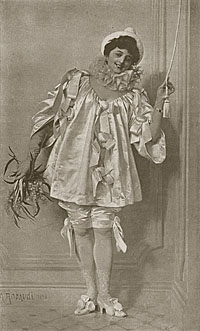
|
In French pantomimes they have a character called Pierrot, who is practically equivalent to an English
stage clown. He is dressed and made-up as a young boy, and his business on the boards is to be as stupid,
simple-minded, cunning, and malicious, and above all funny, as a young boy can be in real life.
Pierrette, or Mademoiselle Pierrot, like Pierrot, makes up as a young girl, and behaves
as mischievously, though not as stupidly, as he. In the picture by Robaudi he shows
one of these femine counterparts of the clown, all silk and satin, who returns
from a masked ball and rings for admission into her apartment, holding a trophy of
the evening in her hand. The artist is an Italian by birth, a pupil of the Paris
art schools, and has his studio in Paris. The example
which we present of him was first exhibited in the Salon of 1891.
|

|
Georges Pierre Marie Van den Bos, in spite
of his name, which smacks strongly of the Netherlands, is a Swiss by birth,
and has his studio in Paris. His "Prey of Cupid" serves as a good example of his style.
|
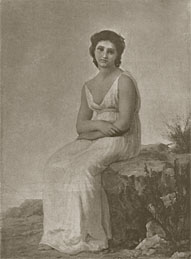
|
Jean Benner, the painter of "Reverie,"
is the twin brother of Emmanuel Benner, several examples of whom
have been given in this work. He, like his brother, was a designer for the factories
until about thirty years of age, when his savings enabled him to study painting. he went to Italy in `866, after
having had instruction in Paris from Pils, Henner, and Leon Bonnat. He had exhibited pictures
at the Salon, however, since 1859, and since 1872 has received a number of medals.
|
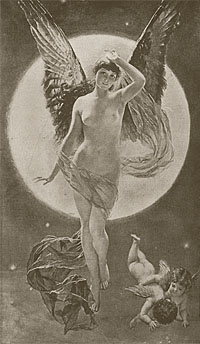
|
"Night"
is a decorative and beautiful composition by a Flemish artist, resident in Paris,
A. de Courten.
|

|
The prohibited book
is the one which is always certain to be read. This young
person has been commanded not to read a certain novel - and she takes it to bed to read and dream over.
Fritz Zuber-Buhler, the artist, was born at Locle,
in Switzerland. Locle is a town chiefly devoted to
the manufacturing of watches, and as the boy had a taste for drawing he was employed to
engrave designs on the cases of the higher priced pocket time pieces. In its small way, this
engraving for the jewellers is a profitable business to the employees, so Zuber-Buhler was able
in time to go to Paris to study painting. He there was a pupil of Picot and of the Swiss painter
Grosclaude, and under them became an accomplished technician, while he developed a power as a colorist quite uncommon with painters
of his nationality.
|
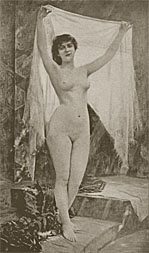
|
Albert Aublet is a Parisian, a pupil of Jacquand and of Gerome, and made the
regular course of a student at the School of Fine Arts. A visit to Constantinople next added subjects
of Oriental life to his repertory, and led to the completion, among others, of his "Turkish Woman at the Bath,"
whose appearance at the Salon in 1883 was received with great applause and materially added to his
fame and prosperity.
|

|
At the outpost of an Arab camp, the favorite slave girl of the Sheik, with his
pet hound, the guardians of his tent, are on the outlook for their master's return from a hunting excursion.
The artist, Gaston C. Saintpierre,
is a native of Nimes, and studied art in Paris under Cogniet and Jalabert.
He made various excursions into Algiers and the deserts of North Africa, from which he returned
with a valuable collection of motives. He received his first medal in 1868, and the Legion
of Honor in 1881.
|

|
The story of Blaise Bukovoc has been given in detail in a
previous part of this work. His "White Slave" represents one of the Greek or
Circassian girls who were frequently to be found in Turkish harems, into which they came as spoils
of war.
|
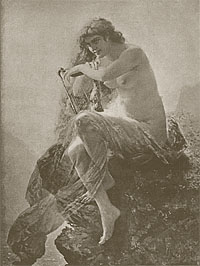
|
The legend of Lorelei, the siren of the Rhine, is one of those which
the Germans adopted from classical antiquity and adapted to local surrounding and circumstances.
William Kray represesents the lovely and loveless enchantress seated on the
craggy summit of the cliff, which is nearly five hundred feet above the level of the stream, bathed in the beams of the moon,
and by her alluring glances inviting the hapless boatmen to their destruction.
|
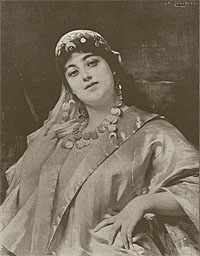
|
"Fatima"
is another of the always popular feminine types of Nathaniel Sichel
of Berlin, a queen of the harem, robed in satin and wearing a headdress of great golden
coins and jewels.
|

|
Konrad Dielitz is a German portrait and genre
painter of high rank. He was born in 1845 in Berlin, and was the son of a well-known literary man.
He made his first stroke of fortune as a portrait painter, and the reputation he
thus gained brought him an appreciative public for his genre, historical, and
legendary compositions. In "The Daughters of the Rhine"
he takes up the legend of the water-fairies who guard the fabulous treasures of that
picturesque stream, upon which Wagner founded his opera of the "Rheingold."
|

|
Jules Lefebvre
whose biography has already been given, presents in "Antique Poesy"
a young girl who in a poetic competition has won the coveted wreath of honor.
In the simple or antique times it was a wreath of fresh laurel. Later it became
a wreath of silver in imitation of laurel. It is such a wreath that the figure in the picture
means. The practice was continued into medieval times, especially in Italy and France, long after Christianity had spread over Europe and Paganism had completely disappeared
from the civilized portions of the world.
|
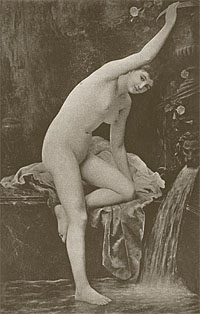
|
Mlle. Marie Rose Vasselon, who was born at Craponne in the Department of
the Upper Loire, exhibited in earliest childhood a most astonishing artistic talent.
She seemed to learn to draw by instinct, for she had enjoyed no instruction apart from that which
was afforded by the pictures and engravings in her home. A
Madame Thoret, a very able woman painter of the time, gave her her first actual instruction in
art. She then went to Paris, where, while studying in the art school, she also became a student
under Carolus Duran and Henner. Her first successes were made in portraiture, but, strongly
influenced by Henner, she commenced to make a specialty of the study of the nude, of which "The Bath" is a convincing example. Miss Vasselon shows in her pictures
a wonderfully fine appreciation of color, and great accuracy and skill in drawing. Her
technique is big, broad, and free, and her execution perfect.
|

|
The "Nymphs" of Bouguereau is one of his
famous pictures. it is a subject which explains itself.
|
|
|
|





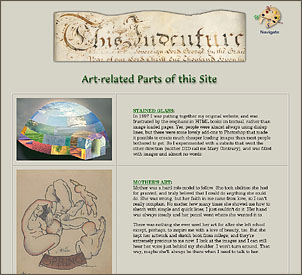



![]() Copyright © 2007, Mary S. Van Deusen
Copyright © 2007, Mary S. Van Deusen